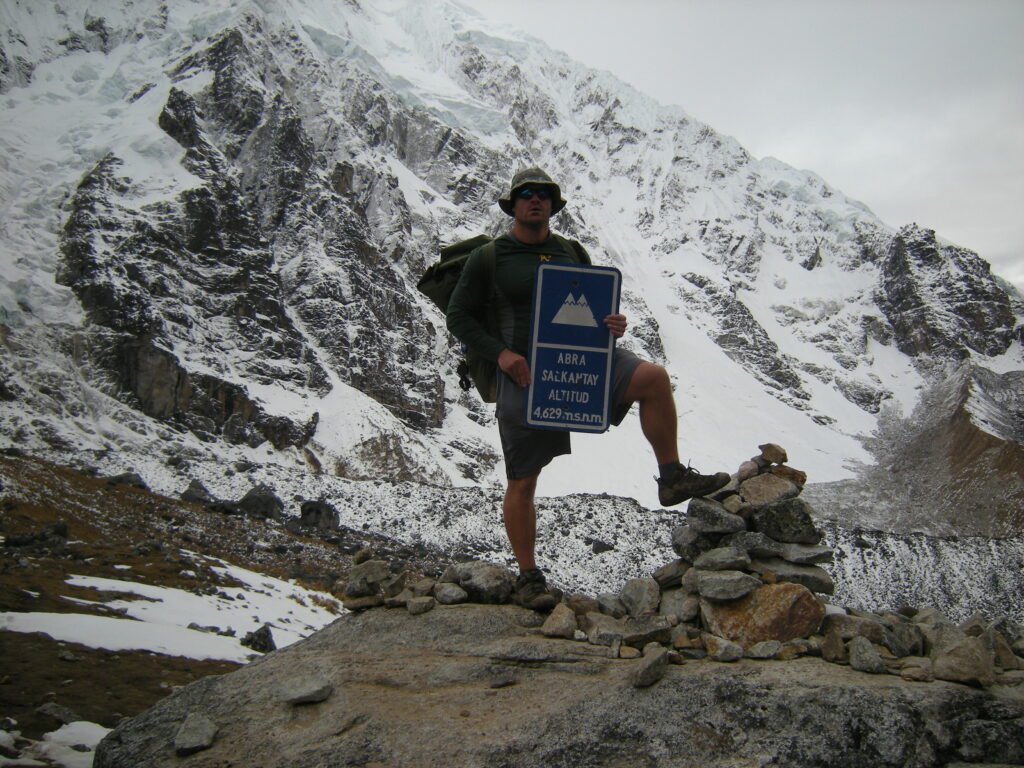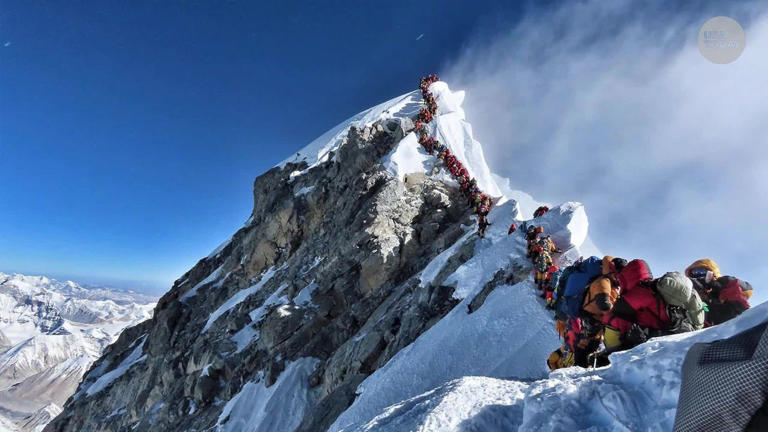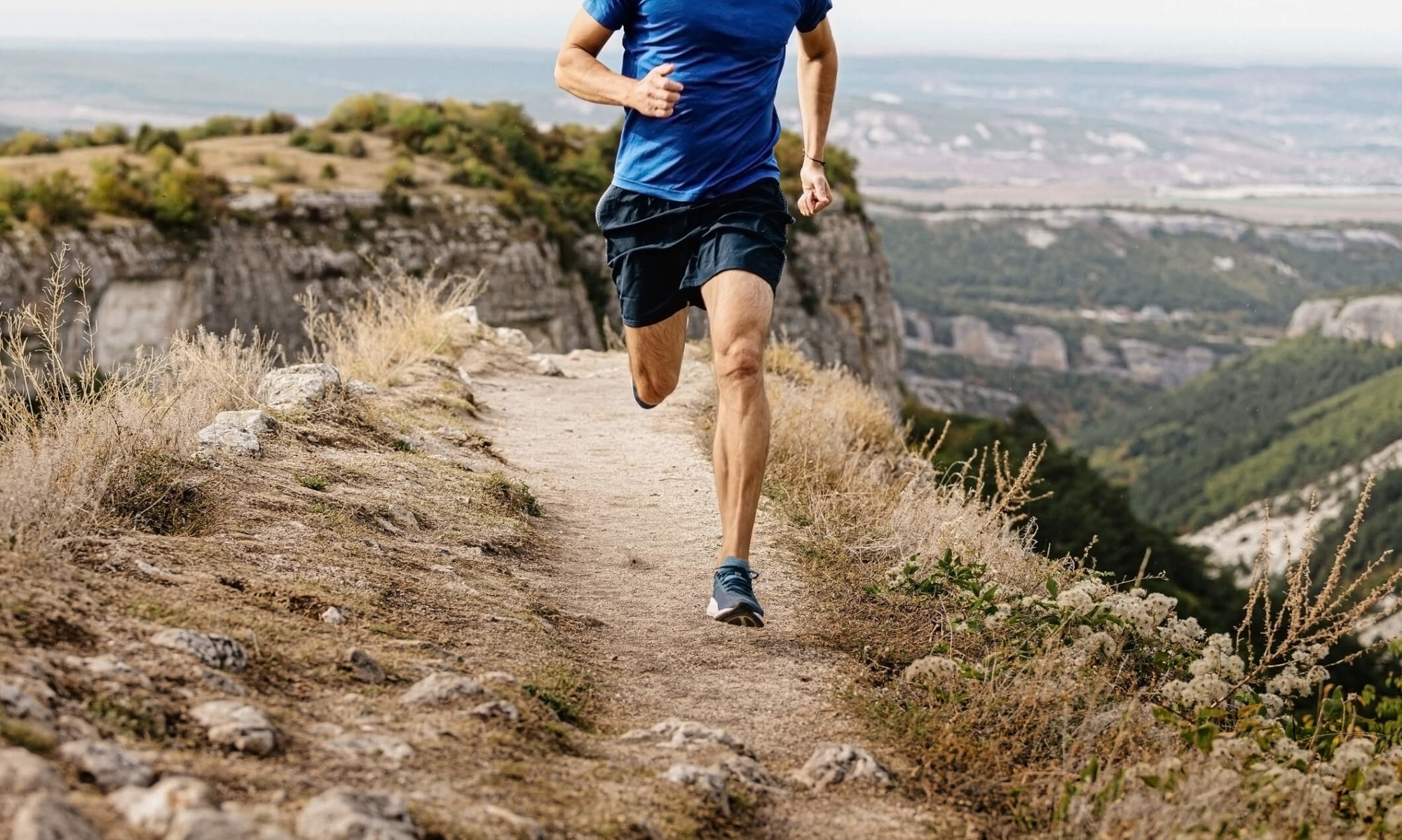
The author at 15,200 feet atop Salkantay Glacier in the Andes mountains of Peru.
Atmospheric oxygen makes up about 21% of the air humans breathe. At extreme altitudes, the percentages of oxygen and carbon dioxide stay the same, but their partial pressures in the atmosphere decrease exponentially, making it difficult for these gases to cross the blood-lung barrier in sufficient quantities during any amount of physical exertion. The body contains 100 times more carbon dioxide than oxygen. After being inhaled, air exchange takes place along pressure gradients across lung capillaries, where hemoglobin found in red blood cells is key for delivery. Following its uptake by exercising muscle tissue, oxygen depleted (and CO2 enriched) blood returns to the heart, prior to its delivery back to the lungs. Exercise at altitude produces greater physiological demand on the body by increasing heart rate, total ventilation, and blood lactate levels.
Although left ventricular size has been show to increase with aerobic exercise, muscular atrophy can take place with extended amounts of time at extreme elevations. Aerobic training can improve VO2 max and stroke volume, while also helping to decrease lactate production. Anerobic events are less affected by high altitude, where a fascinating limitation is imparted on the central nervous system. Here muscular activation is limited in order to preserve vital functioning for the brain, heart, and lungs – where heart rate and cardiac output are already markedly decreased. Oxygen demand can become twenty times higher during intense exercise than at rest. Shunting of blood flow takes place, causing more of the blood to be redistributed away from other organs in order to supply active tissues.
Above 4, 000 ft MSL, VO2 max exponentially decreases by 10% with every 1,000 meters in elevation, to a point where humans can sustain only 25% of their max VO2 at heights comparable to Mount Everest. A 1981 study showed that mountain climbers with a measured VO2 of 60 could only achieve 15-20 ml/kg/min near the summit. Average weight loss among the group was 15 lbs – mostly lean muscle tissue – and caloric intake decreased 45% in the hypoxic conditions. It is important to realize, however, that even top mountaineers like Reinhold Messner or Sir Edmund Hillary never possessed VO2 maxes above 50 mL/kg/min. Rather, they were just likely to be more efficient while performing in hypoxic environments with greatly reduced partial pressures of oxygen (hemoglobin can still combine with O2 at altitude in partial pressures as low as PO2=60); perhaps training their chemoreceptors to have a lower sensitivity to carbon dioxide. Free divers train with restricted breathing to accomplish similar feats – albeit while submerged hundreds of feet underwater. Even the air at Everest base camp (17, 600 ft) contains only half of the oxygen found at sea level. Elite athletes may use hypobaric tents or chambers that can simulate the air pressure seen at elevations of 2,000-3,000 meters – and some experiment with masks that restrict oxygen inflow. Simply living (without training) at altitude can benefit athletes; however, it typically takes at least 3 weeks for a person living at altitude to increase RBC production or enhanced oxygen delivery, whereas these adaptations last no longer than a few weeks upon returning to lower elevations.

Supplying a healthy person with 100% pure pressurized oxygen is no guarantee of enhanced absorption – and can even lead to decreased RBC counts, congestion, sore throat, coughing or toxicity if administered for long periods. While this certainly can increase safety and capability at great heights, some climbers using supplemental oxygen to surmount Everest have still likened the experience to “running on a treadmill while breathing though a straw.” Some of them have resorted to using different steroids to cope with hypoxia, although anything that increases blood hematocrit levels can be critically dangerous at high elevations.
Above the Death Zone, (25,000 ft) the oxygen level is insufficient to allow recovery of most human tissues. Cells in the brain and lungs can die out in minutes, and risks for heart attack and stroke become exponentially greater. Some of the first symptoms of acute mountain sickness are nausea and dehydration, with a decreased to desire to eat or drink. This can be accompanied by disorder thinking (I have experienced both nausea and delirium between 13,000 – 15, 000 feet) and migraines. Climbers exposing themselves at high altitudes can also endure snow blindness, frostbite, and persistent coughing fits – sometimes severe enough to fracture ribs. In later stages, a condition known as HAPE (high-altitude pulmonary edema) causing fluid to leak into the lungs can also be fatal. This is more likely to occur at elevations over 2, 500 meters. Another even more deadly condition is HACE (high-altitude cerebral edema) where the brain can begin to swell resulting from the lack of oxygen.
To mitigate these risks, experienced mountain climbers and endurance athletes usually adopt a “live high, train low” philosophy – often giving themselves up to four weeks to adapt at high altitudes. In the weeks-long push to attain Everest, climbing teams will ascend close to a vertical mile per day before returning down to sleep lower, a stairstep approach that lessens the risks for serious altitude sickness while also peaking physiological adaptations. Elite running teams will often commute to locations several thousand feet above where they sleep for daily workouts, choosing to recover each night back down at moderate altitudes with a sufficient amount of oxygen present. They still live high enough to elicit increases in red blood cell mass, and their blood lactate response can be significantly decreased after 3-4 weeks of training at altitude.
Just before entering college, I successfully ascended Arizona’s highest peak before attempting the highest point in the continental U.S. (Mt Whitney) five years later. In both cases, my climbing partners suffered from altitude sickness, and in the latter we were turned back just 1,500 feet from the top by an ice storm. Five years later, I suffered the effects of altitude sickness myself when hiking above 15, 000 feet in the Peruvian Andes. It is important to educate yourself and be aware of your limits before attempting any intense physical endeavors at altitude; however, with proper training and acclimatization, one can increase their chances of success.
-CHRIS BORGARD
